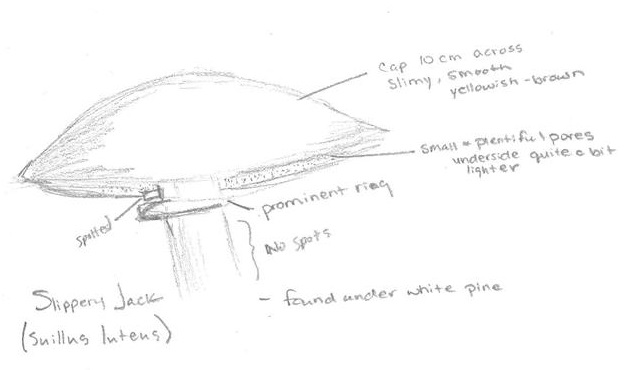This article was written (and illustrated!) by Courtney Lafleur, Senior Park Clerk at Murphys Point Provincial Park.
Time spent in nature can have a profound and lasting positive effect on our physical and mental health, and journaling has long been heralded for its own health benefits. Put them together and you’ve got nature journaling; an activity that inspires creativity, mindfulness and connectivity with nature.
In the simplest terms, nature journaling is about looking at the natural world around you and recording your thoughts and observations. You don’t need a lot to get started, just a piece of paper and something to write with.
Good tip: Try to avoid buying fancy and expensive notebooks and pens until you know what type of journaling is right for you. Once you get started, you will most likely find a style all your own, and can then decide what additional supplies you need (if any).
The great thing about nature journaling is that you can adapt it to fit you.

Getting a feel for nature journaling
- Start with the date, time and location. Feel free to add things like weather and wind conditions, who you are with, or any other details you feel are important
- Look around, what catches your eye? Maybe there is a cool mushroom on the ground. Give it a quick sketch, note down colour, size, and any interesting features. If you know what type it is, write that down too, or look it up later in a guidebook
- Try sketching the same thing multiple times, putting in various amounts of detail. Not every sketch needs to perfect. By experimenting with the time you give yourself to sketch, you will learn what details are more important to include and how to capture those effectively
- Experiment with mediums. Try different paper, pads and notebooks. If you like writing, try lined paper. If you are an artist, a sketchbook may be perfect. Try pens, pencils, watercolours, ink and makers. What does your mushroom look like as an ink drawing vs. coloured pencil?
- Keep your journal with you. Practice makes perfect, so keep your journal handy and add to it as frequently as possible. Make your “nature time” a priority
- Check out programs in your area. Many parks and educational networks run nature journaling programs. There are also lots of great resources online
For those seeking calm
If you are using your time in nature to focus on healing, meditation or mental health then writing poems and thoughts in your journal may be helpful to you. Take a look around you and record what you see, hear, feel and smell.

Focus on how these things effect you and make you feel. Maybe you hear loons in the distance and it reminds you of a childhood memory, write it down.
For the scientist
Nature journaling has long been used in the scientific community to detail precise findings and observations. If you are a scientist at heart, why not include things like latitude and longitude, ground temperature vs air temperature, and technical drawings with detailed notes.

You may find it helpful to have things like a good ruler, magnifying glass, compass and other such tools on hand. Try tracking the growth of a plant over time, or the cycle of a butterfly.
For the artist
The artistically inclined may find that drawing and watercolour come naturally, and can use nature journaling to practice realism and observational skills.

Try playing with shadow and light, perhaps detailing the same plant or landscape at different times of day or in different seasons. Does the change in light, change the colour of the plant? What about texture? Try to get those tiny details.
For the bullet journal addict
A bullet journal is where you can keep your to-do lists, agenda, bucket list and so on. And there are many great spreads for those looking to add some nature to their bullet journal.

Why not try creating a bird checklist? Or an Ontario Parks bucket list? Track your daily nature observations right along with your to do list. Add some pages for quick sketches, like of a tree you see on your lunch break or an insect in your backyard.
Inspired yet?
- Try tracking the sunrise and sunset for a week
- Track and sketch the phases of the moon or constellations
- Create a full log of your favourite hiking trail, detailing as much as possible
- Compare two different species, like white and red pine
- Get a magnifying glass out and zoom in on something tiny
- Take a picture and tape it into your journal if your short on time (or artistic ability)
- Make a plant rubbing (*remember — never pick or damage natural objects in provincial parks)
- Try group journaling. How do different people see the same flower?
- Look at the same scene from different angles or distances. What is in the foreground, vs. the tree line, vs. far in the distance?
For more inspiration check out johnmuirlaws.com and Keeping A Nature Journal by Clare Walker Leslie & Charles E. Roth.
Don’t put limits on what you can or can’t do when journaling. Remember it is your journal, and your time to connect with nature.
